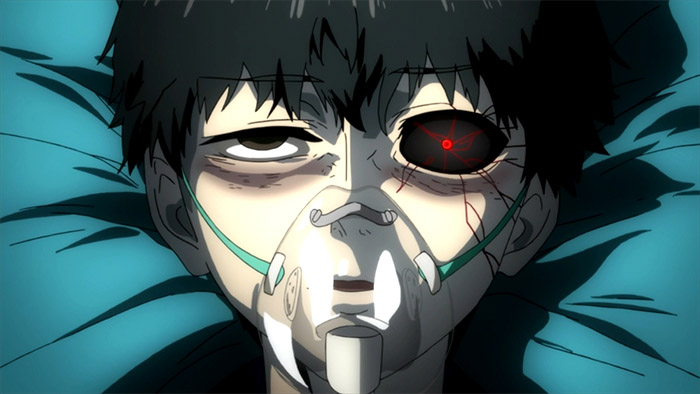Summer is a time to go to conventions and watch more anime! One of the animes I have watched so far this summer is Tokyo Ghoul. This anime based on the manga by Sui Ishida definitely had me hooked from the first few moments. With its mixture of gore and moments of tenderness, I definitely found myself binge-watching. I also found it to be quite the psychological thriller. (*SPOILERS ahead*)
Tokyo Ghoul follows the story of Ken Kaneki, an average college student. He lives in a world inhabited by humans and ghouls – creatures that survive on human flesh. Kaneki develops a crush on a cute girl he sees at a cafe, Rize Kamishiro. It is when he takes Rize out on a date that his entire world changes forever.
Kaneki's date night turns into a nightmare. He experiences a series of multiple traumas, and ends up in a hospital requiring emergency organ transplants. In a very dramatic and painful sequence of events, he discovers that the organs he received were from a ghoul, and have turned him into a ghoul-human hybrid. He discovers he cannot eat human food, he cannot hurt his body easily, and perhaps worst of all, he begins to crave human flesh. He experiences a crisis of identity.
Kaneki has multiple breakdowns after he discovers the changes in his body chemistry. As he tries to make sense of his new self, he is welcomed into a community of ghouls who live amongst humans, and who teach Kaneki how to survive without taking human lives. They provide a sort of ghoul intervention and offer a strong social support network. From a mental health standpoint, intervention and proper support networks are invaluable to someone experiencing a crisis. But this is not always enough. Despite finding a place where he is accepted, Kaneki has trouble seeing himself as "good."
At this point Kaneki has lost the person that he used to be, and is having a difficult time adjusting to his new brain chemistry. He is used to thinking of ghouls as being entirely "bad" because of what he sees in the news constantly: stories of humans being killed by ghouls. This black-and-white, "us" and "them," Sith Lord mentality is often seen in society and it creates a stigma against the "others" as being all "bad." Kaneki is a person who has tried to be "good" to the extreme all his life, enduring pain so that others do not have to. He cannot accept the concept of both "good" and "bad" existing within him at once. His feelings of self-deprecation, along with societal stigma, lead to his difficulties accepting himself. He struggles with remaining as human as possible, only using his ghoul strength when absolutely necessary.
 |
| Kaneki embracing his ghoul side |
Adjusting to new circumstances that are outside of our control can lead us to fear losing control over other areas of life. This fear can lead us to avoidance of certain places or people. In Kaneki's case, it seemed he tried to avoid his best friend and his college life for fear that he might lose control of himself in front of others. Many people with either mental health disorders or substance use disorders might experience a similar fear of being unable to control their mood or their urges in front of loved ones. Avoiding loved ones can sometimes lead to loss of relationships, thereby a loss of our support network, which can make it harder for us to overcome difficulties.
Perhaps if Kaneki had opened up to his best friend, Hide, earlier, he would have realized that Hide would accept him as he was (which was the case when this conversation happened at the end of the second season). The extra support may have given Kaneki the strength he needed to face his fears and begin to accept himself.
 |
| Kaneki carrying Hide's body |
Sadly, the story of Kaneki does not seem to have a happy ending. He undergoes various traumas throughout the first and second seasons, and it is not until the end that he is able to resolve his identity, but perhaps it is too late. For Kaneki, surviving the ordeals he went through meant not only identifying with and embracing the parts of himself he had initially rejected, but rejecting his humanity and becoming what he feared the most: a monster.












Post Comment
Post a Comment